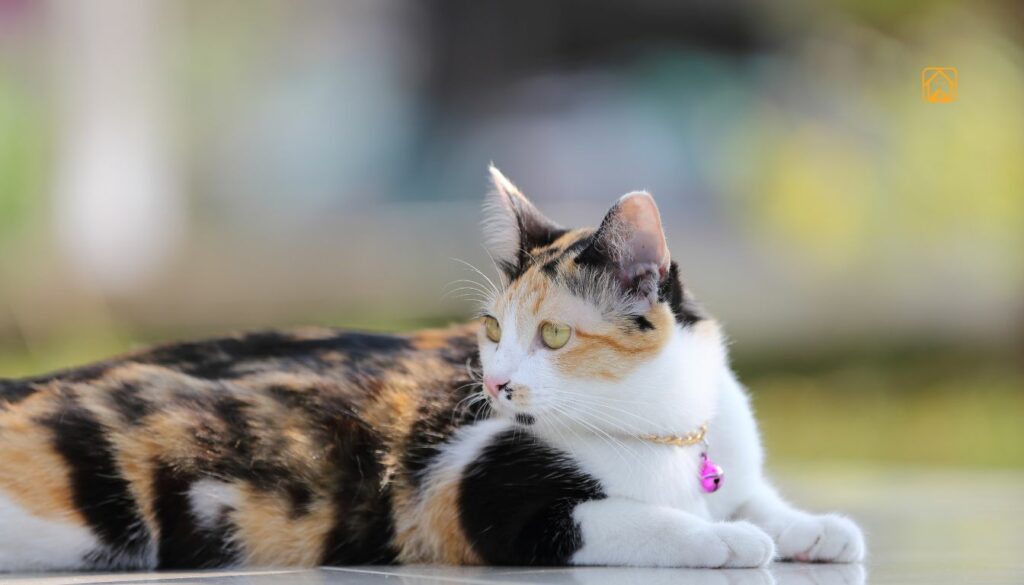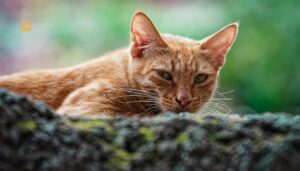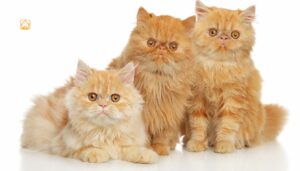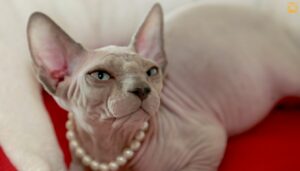What is a Calico Cat? Defining the Calico Pattern
As mentioned a calico cat isn’t a breed, it’s a term for a cat with a tri-color coat. Calico patterns are defined by bold patches of white, orange (or red), and black. Sometimes you’ll spot softer versions, called dilute calicos, featuring grey, cream, and gold instead.
Each calico cat’s pattern is as unique as a fingerprint, with no two ever the same. The defining feature is the presence of three distinct colors, usually with plenty of white. This sets calicos apart from tortoiseshell cats, who have blended or marbled colors instead of patches.
Calico Cat Genetics: Why Most Are Female
Here’s where things get wild, almost every calico cat you meet is female. Why? It comes down to genetics and the X chromosome. The genes that control a cat’s orange and black fur colors sit right on the X chromosome. Female cats have two X chromosomes (XX), so they can carry both black and orange. Males only have one X and one Y (XY), so they’re typically either black or orange, not both.
Every now and then, a genetic anomaly causes a male calico cat to be born with an extra X (XXY), a condition called Klinefelter Syndrome. But this is super rare, only about 1 in 3,000 calico cats is male, and they’re almost always sterile.
I still remember the first time I met a male calico at a shelter. The staff acted like he was a celebrity. It’s not every day you meet a medical marvel on four paws.
Calico Cat Personality and Temperament
While “calico cat personality” isn’t an official scientific term, many people notice some common traits among these patchwork kitties.
- Bold and confident: Calicos are famous for their spunky attitude. Some call it “calico attitude” or even “catitude.” They often know what they want, and aren’t afraid to ask for it!
- Affectionate (on their terms): Calico cats are loyal and can be deeply loving. Many bond closely with one person, but plenty are social butterflies.
- Playful and active: Expect bursts of energy, chasing toys or climbing to survey their “kingdom.”
- Independent streak: Calicos can be a little stubborn. They like attention, but also value alone time.
Some research suggests a link between coat color and certain behaviors, with calicos showing a bit more boldness or even occasional feistiness. But remember, personality depends a lot on breed, upbringing, and individual quirks, not just coat color.
Calico Cat Coat Types
Since calico is a color pattern, not a breed, you’ll find calico cats in many breeds. The most common types include:
- Classic (Standard) Calico: Bold black, orange, and white patches
- Dilute calico: These cats trade the deep colors for pastels, think grey (sometimes called blue), cream, and light orange. Still unmistakably calico, just softer.
- Tabby calico (caliby): This type has the classic calico colors but with tabby stripes or spots mixed in.
- Fluffy calico: Long-haired calicos, such as the Persian calico cat, look especially majestic. You might even spot a fluffy calico with a lion-like mane.
- Black or grey calico: In some, the black or grey dominates, but you’ll always see at least three distinct colors.
- Grey Calico Cat: A dilute with grey instead of black
You’ll find calico cats in breeds like American Shorthair, Persian (calico Persian cat), Maine Coon, Japanese Bobtail, and even Scottish Fold. Each breed gives calicos a slightly different look and sometimes personality quirks.
| Coat Type | Example | Common Breeds |
| Short-haired | Classic, bold patches | American Shorthair, Domestic Shorthair |
| Long-haired (fluffy) | Flowing, soft fur | Persian, Maine Coon |
| Dilute | Pastel colors | Any breed with calico pattern |
| Tabby calico | Stripes mixed with patches | Domestic Shorthair, Turkish Van |
Eye color can be just as varied, green, yellow, blue, or even “odd-eyed” (one blue, one copper). Their noses are often pink, but sometimes match their coat spots.
One fun fact: the calico cat’s coat markings are unpredictable, so no two are ever identical. Some have more white, others more color. They come in all shapes and sizes, but always with a tri-color twist.
Caring for a Calico Cat: Grooming, Nutrition, Lifespan and Health

Taking care of a calico cat depends on their breed and fur type.
Grooming Tips for Calico Cat Hair
Calico cat hair can be sleek and short or long and fluffy, depending on their breed. My neighbor once had a fluffy calico who honestly, shed more than any cat I’ve owned. Some days it looked like she was trying to knit a new cat out of her fur on the couch! Here’s what helps:
- Short-haired calicos: Brush them once or twice a week to remove loose fur and keep their coat shiny.
- Fluffy calicos (like Persian calico cats): Daily brushing is your best friend. It prevents tangles and those dreaded hairballs.
- Pay close attention to behind the ears and under their arms, knots sneak in there.
- Trim nails every couple of weeks, and check their ears for dirt or wax.
Nutrition: Fueling Your Calico’s Health
While calico cats don’t need a special diet because of their coloring, their nutrition should match their life stage and breed. For example, a Persian calico cat might need a food that helps with long-hair health, while a tabby calico’s needs may be simpler.
- Feed a complete and balanced diet, check for AAFCO or FEDIAF approval on the label.
- High-quality protein supports healthy skin and fur that gorgeous calico coat.
- For fluffy calicos, omega-3 fatty acids help reduce shedding and matting.
- Watch their weight! Calicos, especially indoor ones, can put on pounds fast. Use a measuring cup for meals and keep treats in check.
Health Considerations: What to Watch For
Most calico cats are just as healthy as any other, but there are a few things to keep on your radar:
- Male calico cats (the rare ones) may have Klinefelter Syndrome, which can cause bone weakness, weight gain, and developmental delays. They need regular vet check-ups and sometimes special diets.
- Female calico cats don’t have health problems because of their color, but their breed might matter.
- All calicos need regular vaccines, dental care, and parasite prevention. Don’t skip those annual checkups!
Lifespan of Calico Cats
A healthy calico can live 12–16 years or even longer with good care. And if you notice any sudden changes, like less grooming, hiding, or eating less, don’t wait to call your vet. I’ve learned that cats are masters at hiding illness, so trust your gut if something seems off.
Calico Cats in Culture, Folklore, and History
Calico cats have charmed people worldwide.
- In Japan, they’re known as Maneki Neko (lucky cats), you’ve probably seen the waving cat figurines in shops and restaurants.
- German folklore calls them “glückskatze,” or lucky cat.
- In the U.S., the calico cat is the official state cat of Maryland, thanks to their matching colors with the state bird and butterfly.
Many believe calicos bring good luck and prosperity, who couldn’t use a little extra fortune?
Adopting or Buying a Calico Cat: What to Know
If you have your heart set on a calico cat, you’re in luck, many shelters have calicos waiting for a home, though you may need patience to find the perfect match. Calico isn’t a breed, so you won’t find “calico cat breeders” specifically.
If you want a specific breed (like a calico Persian cat), seek reputable breeders who focus on health, not just color. Male calico cats are incredibly rare and, if available, can cost much more than females, but remember, their health is more fragile.
Adoption fees for a calico cat are usually similar to other cats. If someone tries to charge a premium for a male calico cat, ask about their health and background. And as always, consider rescue first, there’s something special about giving a unique cat a second chance.
FAQs Calico Cat
Are calico cats a breed?
Calico cat refers to a color pattern, not a specific breed. Many breeds can have calico coloring, including American Shorthair, Persian, and Maine Coon.
Why are most calico cats female?
The genes for orange and black fur are on the X chromosome. Females have two X’s, allowing for both colors; males usually have only one.
How rare is a male calico cat?
Extremely rare, about 1 in 3,000 calico cats is male. Most male calicos have genetic conditions that affect their health and fertility.
What is the lifespan of a calico cat?
Female calico cats usually live 12-16 years, depending on their breed and health. Male calicos may have shorter lifespans due to genetic issues.
How can I tell the difference between a calico and a tortoiseshell cat?
Calicos have large, distinct patches of white, orange, and black. Tortoiseshell cats have blended or marbled orange and black, with little or no white.
What is a dilute calico cat?
Dilute calicos have softer colors, grey (instead of black), cream (instead of orange), and white. Their pattern is still patchy and tri-color.
Are calico cats more aggressive?
Some studies suggest calicos may have a feistier personality, but there’s no proof that coloring alone causes aggression. Personality is shaped by many factors, including breed and upbringing.
Conclusion
Thinking about bringing home a calico cat? Trust your instincts, ask questions, and enjoy every quirky, colorful moment with your new friend. There’s nothing quite like sharing your home with a calico, and that’s not just the luck talking.



